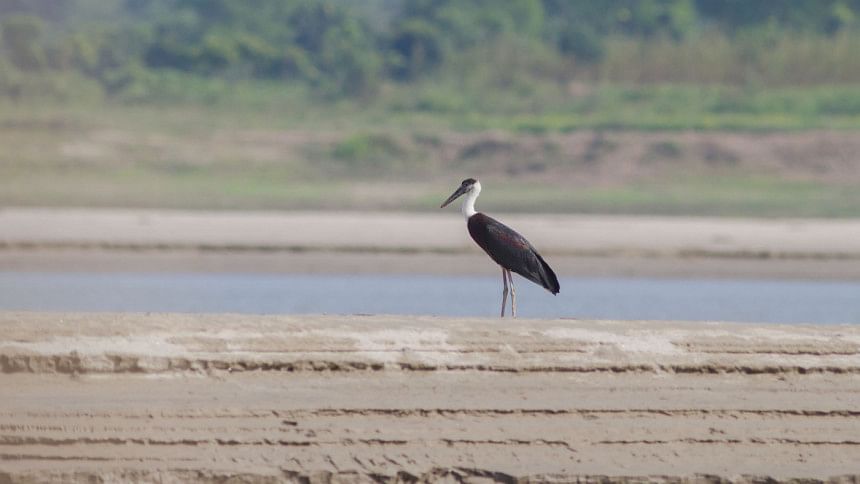World Habitat Day: Habitats not just for humanity, but for life

Early Spring of 2013, Sonadia Island
Through the choppy waters of the Bay of Bengal, our speedboat twisted and turned trying to reach Sonadia Island. The boat, fitted with a Yamaha engine, sprayed us all with seawater and by the time we reached our destination, my spectacle eyed self was hard-pressed to focus on anything. Though it was early spring, the sun was raging and the landscape looked barren beneath it. Yes, it is a pretty island, but what more could it have, I kept wondering.
The people with me, ornithologists by profession, did not entertain my doubts. They jumped off from the boat into the knee-deep water and walked towards the shore. I followed suit but kept wondering, how did life thrive here? In this apparently barren mudflat.
An ornithologist and wildlife conservationist based in Bangladesh explained it best in an article he penned on the significance of mudflats. "It is interesting what people from different backgrounds see when they look at a landscape, the contrast between seen and unseen beauty and value, the urge for preservation versus the greed for alteration. What most people do not see in these coastal mudflats are the hidden treasures of our biological diversity. Every year, more than one hundred thousand birds visit our mudflats to feed on the invisible life that flourishes on mud, silt and clay found in intertidal areas. These areas generally support a range of invertebrates, which are extremely productive biologically. These include benthic organisms, molluscs, crustaceans and marine worms."
Life happens in each layer of this habitat. Up above in the skies, thousands of northern pintails come flapping their wings… a tad below is the half-sandy, half-muddy plain where scores of shorebirds forage busily for molluscs, worms, little tiny marine organisms brought in by the tidal action that the island is subjected to twice a day.
A layer below the mudflat is the Bay of Bengal. Here is home of the Olive Ridley Turtles, Green turtles, Irawaddy Dolphins and much, much more. The shallow zones support important fish species that contribute to the food security and economy of the nation.
This ecologically important habitat is under a multitude of threats—from development pressures to sand lifting to large-scale tourism plans—and the wildlife that depend and thrive on this land too are left in the lurch.
Winter of 2013, Brahmaputra river in Kurigram
On a biting cold winter morning, three of us boarded a small wooden boat, fitted with an engine, to tour through the chars of Brahmaputra river in Kurigram. We were looking for River Lapwings and Black-bellied Terns, among other birds. This time, I was stumped. For how could life exist in this seeming nothingness, where there was no large looming tree, where only sand banks and grasslands made up the landscape? But train your eye a little, let it adjust to the stillness of the river, and life happens. A River Lapwing couple flies around, toot-toots at each other ringing alarm bells at our presence. For a while, the duo flies around us, zooming past the binocular window in swift motions, then they settle on char—a piece of land that shows up during the dry season.
Photos are taken, the moment written down in notebooks for future research, and we cruise on.
During the rains in Sundarbans
It does not take long for the sky to turn menacingly black from azure blue inside the forest. Again, I find myself on a boat, rowing on with an old weather-beaten man, a woman who has made it her life's mission to visit the forest every year, and a few others. The rain is like a curtain in the mangrove forest. It comes down in sleets and visibility is poor. So, to see wildlife, you have to tune in even more. You tune in your ears and get to listen to the thud of a monitor lizard. Row on ahead and a threateningly low-hanging branch reveals that it is in fact harbouring a white-lipped pit viper.
When the rain stops and you get a moment of respite and watch the forest in the calm of the setting sun, you will be slightly "shook" as a pod of Gangetic River dolphins suddenly come to play.
Days and nights in a restored habitat in Savar
I chanced upon this place by a stroke of luck. This is a vast swathe of land bought some time in the 90s and is now privately owned. Here, mostly native trees, ferns, and plants were sown, some ponds were dug, and a lot was left up to nature. Although used as a residence by the people who own the place, the land is left mostly untouched. Coconut trees, large banyan trees, banana plants, kaminis, hibiscus grow here and there. Here just in the span of a single day, we saw monitor lizards, jackals and scores of birds. Two frogs also made themselves cosy in the house that we spent the night at.
A quiet, very green street in Dhaka
I had to wait for a while a few days back in an alley that was, to my surprise, full of lush trees. With the wise words of a podcast in my mind—ten minutes of nature a day, makes you sharper and wiser (something along those lines, I promise)—I stared at the trees. And lo and behold, soon a woodpecker came and settled on one of the branches. For a while, I marvelled at the sight, then a commotion on the street caught my eye. So, for a while I watched the foodpanda delivery man and the chronicle of a hard-to-locate address. In another little while, I chanced upon little frogs jumping right past apartment buildings. No sooner was I done staring at the tiny frogs, which I swear will fit on my fingertip, than I noticed a movement on the hanging wires. And guess what, a squirrel quickly ambled on it and made it to a tree and was gone from my sight.
What ties all of these places and things together?
It turns out, the first Monday of each October is observed as World Habitat Day. Now when I first sat down to write this piece, I did not have in mind a theme, but a simple search on the internet revealed that this day was in fact meant to ensure safe homes and habitat for humans. It is hard to explain the shock and surprise I felt. While there is no denying the need for safe urban spaces and shelter for humans, especially in the wake of the coronavirus pandemic, it feels strange to see World Habitat Day concerning itself only about humans.
This year, the theme is "habitat for humanity." I am jarred by this anthropocentric approach to matters. Especially now, when the world is acutely aware of the effects of climate change, the degradation of habitats and the loss of biodiversity. This very pandemic too can be blamed on degrading habitats, trafficking of wildlife and general disregard for nature. If we do not ensure safe homes for all creatures that occupy this planet, then we genuinely risk losing our only home: Planet Earth.
I come with an alternate plan to observe this day. Perhaps we should ensure habitat for all forms of life, not just humanity?
Abida R Chowdhury is a journalist at The Daily Star, with a background in environmental science and a keen interest in animals and wildlife.

 For all latest news, follow The Daily Star's Google News channel.
For all latest news, follow The Daily Star's Google News channel. 



Comments